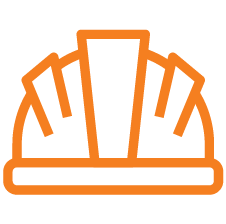Starting a new DIY project can feel stressful and daunting. From a lack of experience to time and budget constraints, many of us convince ourselves that these projects are best left “for tomorrow”.
At Coastal Hire, we understand the importance of taking the first step and have put together a list of our favourite DIY equipment to hire. Below is an overview of each machine, tips on how to use it and the benefits of hiring for occasional projects.
Are you embarking on a project that involves compacting soil, gravel or asphalt? A plate compactor is a powerful and versatile machine that includes a heavy, vibrating plate. It efficiently compresses loose materials and creates a stable and durable foundation (by removing air from the soil) for structures like patios, driveways or garden paths.
How to use a plate compactor:
Step 1: Prepare the surface by clearing any rocks and debris. It is also important to ensure that the surface is relatively flat before starting the compaction process.
Step 2: Position the plate compactor on the edge of the area that needs to be compacted. Hold the handles firmly and maintain a stable posture while operating.
Step 3: Engage the engine and let the plate compactor‘s plate make contact with the surface. Allow the machine to vibrate, effectively compacting the surface beneath.
Step 4: Make overlapping passes to ensure uniform compaction.
Step 5: Repeat the process until your desired level of compaction is achieved.
Hiring a plate compactor for your projects will offer you the following benefits:
● Efficiency and speed
● Versatility
● Professional results
Visit our online shop here to get an instant quote.
2. The Wet and Dry Vacuum Cleaner
A wet and dry vacuum cleaner is a robust and versatile cleaning tool designed to handle both wet and dry messes. With powerful suction capabilities, this machine is ideal for a range of DIY projects and applications, from saw dust clean-up to liquid spills. It provides a hassle-free solution to maintaining a clean workspace.
How to use a wet and dry vacuum cleaner:
Step 1: Select the right attachment based on the type of mess you need to clean up. Wider nozzles are suitable for large debris, while crevice tools are perfect for tight spaces.
Step 2: Ensure the vacuum is set to the correct mode, based on the type of clean up required.
Step 3: For optimal performance, empty the tank regularly to prevent overloading and maintain consistent suction power.
Using a wet and dry vacuum cleaner means you can tackle both wet and dry messes with a single tool, eliminating the need for multiple cleaning devices. The other benefits of hiring this machine include;
● Saving time
● Promoting health and safety
Get an instant quote here.
While the country faces loadshedding and an unreliable power supply, a generator is an indispensable tool for any DIY task.
How to use a generator for DIY projects:
Step 1: Choose the right generator by considering the power requirements of your equipment and opt for one with multiple outlets.
Step 2: Use the recommended fuel type (petrol or diesel).
Step 3: Set up the generator in a well-ventilated, outdoor area to prevent carbon dioxide buildup.
Step 4: Use heavy-duty extension cords to connect your equipment to the generator and consider using surge protection to protect your equipment.
There are many benefits of hiring a generator for DIY applications, these include;
● Cost-savings
● No maintenance hassles
● Flexible hiring terms
Find the right generator for your project needs here.
When it comes to tackling tough DIY projects like demolition or excavation, a jackhammer is a powerful and versatile tool that breaks through concrete and rock.
How to use a jackhammer:
Step 1: Prioritise safety by wearing the correct personal protective equipment such as ear protection, safety glasses and gloves. Ensure that the work area is clear of obstacles and bystanders.
Step 2: Choose the appropriate bit or chisel for your specific task.
Step 3: Hold the jackhammer with a firm grip and maintain a stable posture. Let the equipment’s weight do the work – there is no need to apply extra force.
Step 4: Begin with a lower impact setting to get a feel for the jackhammer and then gradually increase the intensity as needed.
Step 5: Break the surface into manageable sections, to ensure even and efficient results.
Hiring a jackhammer gives you the power to breakthrough challenges and conquer tough projects. Other benefits of hiring include:
● Cost-effectiveness
● Flexibility
Find the right jackhammer for your needs here.
An inverter welder is a compact and efficient welding machine that provides a more stable and precise welding current. Known for its power, portability and versatility, these welders are perfect for a wide range of metalworking DIY tasks.
How to use an inverter welder:
Step 1: Always wear the appropriate safety gear, including welding gloves, a welding helmet and flame-resistant clothing.
Step 2: Choose the correct welding electrode based on the type and thickness of the metal you are working with.
Step 3: Clean the metal surface thoroughly, removing all dust and paint.
Step 4: Adjust the current and voltage settings according to the specifications of your welding project.
Bonus tip: practice your welding technique on scrap metal first to get a feel for the machine and to ensure that you achieve clean and strong welds.
Get an instant quote here.
With Coastal Hire, you don’t have to let your DIY projects become a waiting game. We can assist you with top-quality equipment hire, expert advice and guidance.



